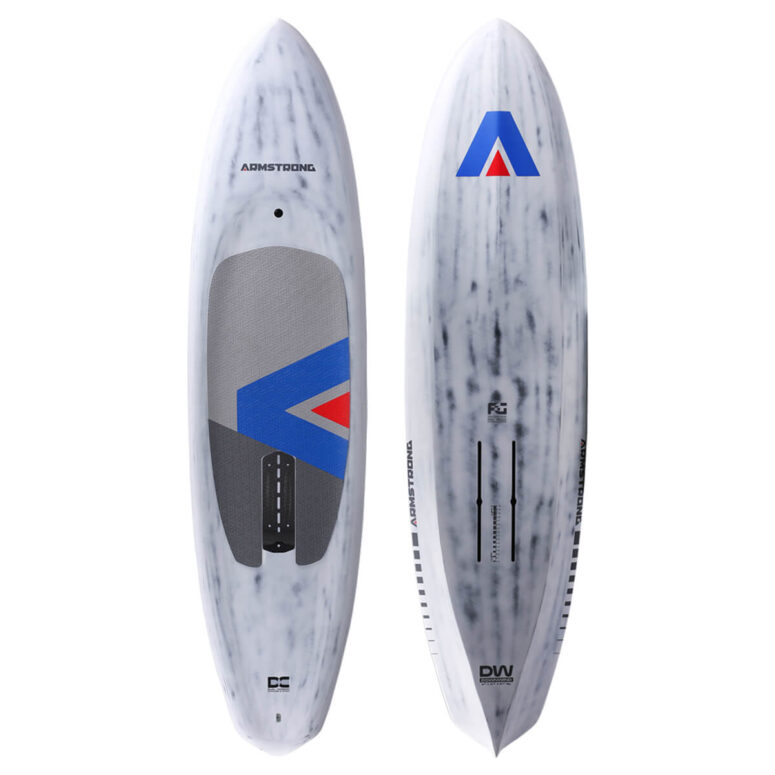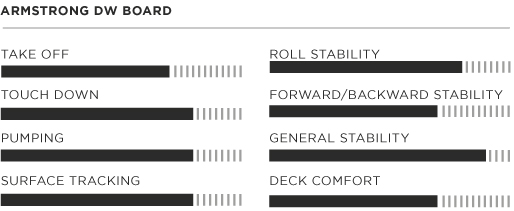

When you purchase gear through links on our site, we may earn a small commission. Here’s why you can trust our tests and our affiliate partner.

A household name in the foiling world and one of the first brands to embrace downwind SUP foiling, it comes as no surprise that Armstrong were one of the first brands to bring out a full line of production SUP downwind boards. Coming in the trademark white, blue and red Armstrong colors, the DW board is available in five sizes ranging from 6’3 to 8’3, of which we tested the 7’2 107L board in the magical bumps of Hood River, in both lighter and stronger winds as well as flatwater. Interestingly Armstrong have not gone as long and narrow as some of the market, opting to have what could be perceived as a slightly more all-round size.
Built with a Carbon PVC Innegra construction the boards are light and sturdy and definitely able to take a knock, something that is often overlooked in the quest for weight saving. A double stringer makes the already stiff construction even stiffer, allowing for a more direct feel when pumping with max power transfer. 16” long and forward placed tracks mean that pretty much all foil brands and personal preferences for mast placement are covered and a decent deck pad with separate tail kick (you can stick it on where you want) rounds off a solid and well thought out board. The icing on the cake with the Armstrong DW boards is that they also come with a high quality board bag as part of the price, an essential piece of kit to keep your board in good shape during transport and travel.
The nose of the board starts with a V that transitions to a double concave through to the boxes with soft rails in the front of the board, these allow the board to recover effortlessly when touching down. Additionally the concave in the bottom aids stability. When standing on the board, it was surprising how stable it was given the dimension 7’2 x 20.25”. Going to the back of the board, the edges get harder to aid release and pin tail aids tracking as well as reducing drag on touchdowns with the tail.
As already mentioned, the board is remarkably stable for its size and paddling up the board on foil is relatively easy. The concave can prove to be slightly sticky if you bury your weight onto the front of the board (a habit I had from my own board), but with a bit more back foot pumping getting the board to release is effortless (minor adjustment and not really a negative). Once you’ve adjusted to how the board needs to be paddled and pumped, it goes like a rocket. Paddle ups were effortless, both in the bumps and during flatwater paddle ups and once on foil, the board is a pleasure to ride. The fact it isn’t too long, whilst still being easy to paddle up means the surf experience is great and I would also happily take this board out SUP foiling in waves. The forward boxes combined with the volume distribution mean that wherever you end up dialing your mast position to, you won’t have that much board in front of you. In combination with the narrow nose there is plenty of clearance in turns and the lightweight construction means you aren’t hindered by unnecessary swing weight either. When pumping downwind boards, often the tail touches down behind you. With this board touching down or tapping the tail on the bump behind you is only recognizable by the sound it makes as there isn’t really any drag or stickiness thanks to the shape of the tail, and pumping the board is really easy thanks to the stiff construction as well.
The DW has definite crossover potential into lightwind wingfoiling, making for a fantastic displacement craft, where providing you have a little positive buoyancy, you’ll enjoy plenty of stability. The double concave in the nose makes a stirling job of smoothing choppy sea states when heading across wind, and the board glides up onto the foil with little effort required as soon as speed allows, with minimal power required in the wing. The forward placed foil box helps balance the longer board and a light overall swing weight enables a high litreage board feel nimble and not as ungainly as you’d anticipate. The deck dugout also aids in keeping you feeling connected to the board rather than perched on top.
Armstrong has created a board that functions as a true allrounder whilst still excelling at its primary use case (SUP foil downwinding). The stability of this board will give confidence to beginner riders who may find the width daunting, yet the responsiveness and performance of this board means it also appeals more advanced riders looking to push their riding to new levels.
